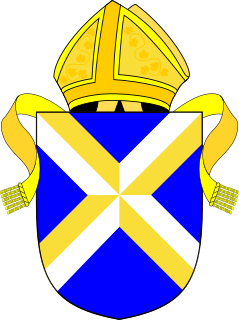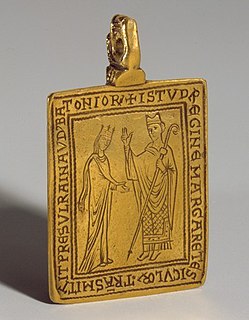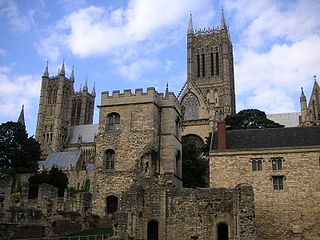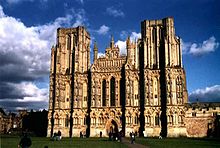John de Gray or de Grey was an English prelate who served as Bishop of Norwich, and was elected but unconfirmed Archbishop of Canterbury. He was employed in the service of Prince John even before John became king, for which he was rewarded with a number of ecclesiastical offices, culminating in his pro forma election to Norwich in 1200. De Gray continued in royal service after his elevation to the episcopate, lending the King money and undertaking diplomatic missions on his behalf. In 1205 King John attempted to further reward de Gray with a translation to the archbishopric of Canterbury, but a disputed election process led to de Gray's selection being quashed by Pope Innocent III in 1206.
Geoffrey Ridel was the nineteenth Lord Chancellor of England, from 1162 to 1173.
Eustace was the twenty-third Lord Chancellor of England, from 1197 to 1198. He was also Dean of Salisbury and Bishop of Ely.

The Bishop of Bath and Wells heads the Church of England Diocese of Bath and Wells in the Province of Canterbury in England.
Henry Murdac was abbot of Fountains Abbey and Archbishop of York in medieval England.

Reginald fitz Jocelin was a medieval Bishop of Bath and an Archbishop of Canterbury-elect in England. A member of an Anglo-Norman noble family, he was the son of a bishop, and was educated in Italy. He was a household clerk for Thomas Becket, but by 1167 he was serving King Henry II of England. He was also a favourite of King Louis VII of France, who had him appointed abbot of the Abbey of Corbeil. After Reginald angered Becket while attempting to help negotiate a settlement between Becket and the king, Becket called him "that offspring of fornication, that enemy to the peace of the Church, that traitor." When he was elected as a bishop, the election was challenged by King Henry's eldest son, Henry the Young King, and Reginald was forced to go to Rome to be confirmed by Pope Alexander III. He attended the Third Lateran Council in 1179, and spent much of his time administering his diocese. He was elected Archbishop of Canterbury in 1191, but died before he could be installed.
Savaric fitzGeldewin was an Englishman who became Bishop of Bath and Glastonbury in England. Related to his predecessor as well as to Emperor Henry VI, he was elected bishop on the insistence of his predecessor, who urged his election on the cathedral chapter of Bath. While bishop, Savaric spent many years attempting to annexe Glastonbury Abbey as part of his bishopric. Savaric also worked to secure the release of King Richard I of England from captivity, when the king was held by Emperor Henry VI.
Geoffrey de Burgh was a medieval English cleric who was Archdeacon of Norwich (1200–1225), Bishop of Ely and the brother of William de Burgh and Hubert de Burgh, 1st Earl of Kent.
John of Tours or John de Villula (died 1122) was a medieval Bishop of Wells in England who moved the diocese seat to Bath. He was a native of Tours and was King William I of England's doctor before becoming a bishop. After his consecration as bishop, he was either given or purchased Bath Abbey, a rich monastery, and then moved the headquarters of the diocese from Wells, to the abbey. He rebuilt the church at Bath, building a large cathedral that no longer survives. He gave a large library to his cathedral and received the right to hold a fair in Bath. Not noted for his scholarship, he died suddenly in 1122.
Simon Langton was an English medieval clergyman who served as Archdeacon of Canterbury from 1227 until his death in 1248. He had previously been Archbishop-elect of York, but the election was quashed by Pope Innocent III.
William of Bitton was a medieval English Bishop of Bath and Wells.
Hugh of Beaulieu was a medieval English Bishop of Carlisle.
Walter Mauclerk was a medieval Bishop of Carlisle and Lord High Treasurer of England.
Seffrid I, sometimes known as Seffrid Pelochin, was a medieval Bishop of Chichester.
Simon of Wells was a medieval Bishop of Chichester.
Ranulf of Wareham was a medieval Bishop of Chichester.
John of Fountains was a medieval Bishop of Ely.

Hugh of Wells was a medieval Bishop of Lincoln. He began his career in the diocese of Bath, where he served two successive bishops, before joining royal service under King John of England. He served in the royal administration until 1209, when he was elected to the see, or bishopric, of Lincoln. When John was excommunicated by Pope Innocent III in November 1209, Hugh went into exile in France, where he remained until 1213.

Richard Marsh, also called Richard de Marisco, served as Lord Chancellor of England and Bishop of Durham.

William of Wrotham or William de Wrotham was a medieval English royal administrator and clergyman. Although a late 13th-century source says that William held a royal office under King Henry II of England, the first contemporary reference to William is in 1197, when he became responsible for, among other things, the royal tin mines. He also held ecclesiastical office, eventually becoming Archdeacon of Taunton, and served King John of England as an administrator of ecclesiastical lands and a collector of taxes.






